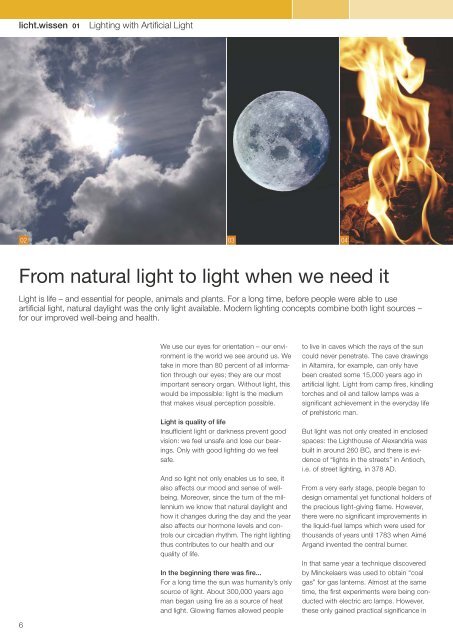licht.wissen No. 01 "Lighting with Artificial Light"
Booklet 1 is intended for all those who want to delve into the topic of light and lighting or wish to familiarize themselves with the basics of lighting technology. It also helps to make a decision in the field of lighting. Free Download at www.licht.de/en
Booklet 1 is intended for all those who want to delve into the topic of light and lighting or wish to familiarize themselves with the basics of lighting technology. It also helps to make a decision in the field of lighting. Free Download at www.licht.de/en
Create successful ePaper yourself
Turn your PDF publications into a flip-book with our unique Google optimized e-Paper software.
<strong>licht</strong>.<strong>wissen</strong> <strong>01</strong><br />
<strong>Lighting</strong> <strong>with</strong> <strong>Artificial</strong> Light<br />
02 03 04<br />
From natural light to light when we need it<br />
Light is life – and essential for people, animals and plants. For a long time, before people were able to use<br />
artificial light, natural daylight was the only light available. Modern lighting concepts combine both light sources –<br />
for our improved well-being and health.<br />
We use our eyes for orientation – our environment<br />
is the world we see around us. We<br />
take in more than 80 percent of all information<br />
through our eyes; they are our most<br />
important sensory organ. Without light, this<br />
would be impossible: light is the medium<br />
that makes visual perception possible.<br />
Light is quality of life<br />
Insufficient light or darkness prevent good<br />
vision: we feel unsafe and lose our bearings.<br />
Only <strong>with</strong> good lighting do we feel<br />
safe.<br />
And so light not only enables us to see, it<br />
also affects our mood and sense of wellbeing.<br />
Moreover, since the turn of the millennium<br />
we know that natural daylight and<br />
how it changes during the day and the year<br />
also affects our hormone levels and controls<br />
our circadian rhythm. The right lighting<br />
thus contributes to our health and our<br />
quality of life.<br />
In the beginning there was fire...<br />
For a long time the sun was humanity’s only<br />
source of light. About 300,000 years ago<br />
man began using fire as a source of heat<br />
and light. Glowing flames allowed people<br />
to live in caves which the rays of the sun<br />
could never penetrate. The cave drawings<br />
in Altamira, for example, can only have<br />
been created some 15,000 years ago in<br />
artificial light. Light from camp fires, kindling<br />
torches and oil and tallow lamps was a<br />
significant achievement in the everyday life<br />
of prehistoric man.<br />
But light was not only created in enclosed<br />
spaces: the Lighthouse of Alexandria was<br />
built in around 260 BC, and there is evidence<br />
of “lights in the streets” in Antioch,<br />
i.e. of street lighting, in 378 AD.<br />
From a very early stage, people began to<br />
design ornamental yet functional holders of<br />
the precious light-giving flame. However,<br />
there were no significant improvements in<br />
the liquid-fuel lamps which were used for<br />
thousands of years until 1783 when Aimé<br />
Argand invented the central burner.<br />
In that same year a technique discovered<br />
by Minckelaers was used to obtain “coal<br />
gas” for gas lanterns. Almost at the same<br />
time, the first experiments were being conducted<br />
<strong>with</strong> electric arc lamps. However,<br />
these only gained practical significance in<br />
6

















